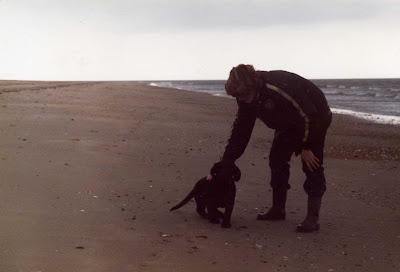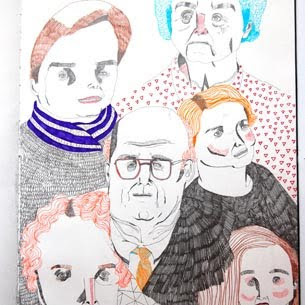Thursday 25 March 2010
Previous work from photographs- finally some drawings!
You arrive on time for the family photograph.
There are definate groupings within this small collection- ones where my parents are young look very different to the photos from my childhood, for example. I just love the compositions and colours.
I wasn't sure whether to put the captions, I think the photos actually are more visually striking on their own without any information.
 Mum and Serbrus on the beach.
Mum and Serbrus on the beach.  Auntie Julie, Auntie Sue (mother's sisters) and Grandma Audrey, and GG(Great Grandma).
Auntie Julie, Auntie Sue (mother's sisters) and Grandma Audrey, and GG(Great Grandma).  The lady in the peach dress is my mum, the man in the stripey shirt is my dad, the lady in the green dress is my Auntie Debbie. I don't know who the others are or where they are.
The lady in the peach dress is my mum, the man in the stripey shirt is my dad, the lady in the green dress is my Auntie Debbie. I don't know who the others are or where they are. This is my dad, his best friend Jan, and my mum.
This is my dad, his best friend Jan, and my mum.
Me and dad. Look at the mountains!
 Nanny and Me. (This is the nanny who's life in the theatre is providing my source material.
Nanny and Me. (This is the nanny who's life in the theatre is providing my source material.
Me, and, I think, Harvey- Jan's son. (see above).
 Nanny and Grandad Bertie at their house in Auton.
Nanny and Grandad Bertie at their house in Auton.
Auntie Julie, Grandma Audrey, GG, not sure, Uncle Nigel.
 Dad and a donkey.
Dad and a donkey. Grandad Bertie and Nanny at an airshow.
Grandad Bertie and Nanny at an airshow. Mum and Serbrus.
Mum and Serbrus. Dad, Dickie, Dawn. And lots of cows.
Dad, Dickie, Dawn. And lots of cows.Magic Lantern Slides

Julia Pott...again!

Julia Pott talks Nostalgia.
They are really very relevant to my project.
First one (i''ll put a link so the pictures are included)NOSTALGIA:
http://shinysquirrel.typepad.com/shiny_squirrel_/2009/08/guest-blogger-julia-potts-inspiration.html
Second one- FOUND IMAGERY:
http://shinysquirrel.typepad.com/shiny_squirrel_/2009/07/guest-blogger-julia-potts-inspiration-.html
just an extract...
"I find rummaging through old books and magazines and photos is one of the best ways for me to draw ideas about composition and style and also a great way to find photographic and graphic material to incorporate into my drawings. If you look closely at my illustrations you can often find old pictures of my mom as a kid lurking in the background, or notes and letters written by my older relatives. Vintage reading material is a also great source of hilarious articles, for example this exert from Cosmo Magazine circa 1979:
" I put on my hired skates and instantly discover ten things I like about roller skating:
1) With your skates on you're three inches taller
2 - 10) When you're three inches taller, everything in life is better'.
And for genius pictures I highly recommend national geographic circa 1960 for it's awesome photography.
I found these awesome 80's muscle magazines in a charity shop in Philadelphia a while back which inspired an entire series on beefy men and a lot of the textures from the household magazines have made it into my animations as the colours of the characters or backgrounds. They're also so great to draw from, it was in a vintage animal magazine that I first found a picture of two animals in love (I believe it was a monkey and a dog) which inspired pretty much all of the subject matter of my work to date. "
This is a really interesting insight into how illustrators that I admire find their source material. It also is inspiring as I know I have great source material and can create some really interesting images if I work hard on this project.
Wednesday 24 March 2010
Sophie Ristelhueber


In this series Ristelhueber creates diptychs of old family photographs with photographs she has herself taken in her family holiday home.
The pairing of the children peering over the gate and the secrets within the space between the two beds - the second image having being taken a few feet from the ground, at child's height- makes us reflect on what children pick up, what they see, what they're not meant to know or see, and probably that they see all these things regardless, and interpret them in their own ways- they will see what they want to see.
Ristelhueber is fascinated with scarring. I found an interview with her from Art World magazine 2009, in which she says if she hadn't lived in that house as a child, she may not be so interested in scars.
Having spent a large part of her career photographing war zones- Kuwait, Palestine... Ristelhueber says the link here between her 'Vulaines' series on memory, and her famous 'Fait' series on land scars and bomb craters is the subject matter of scarring.
I found it interesting to find some work which incorporated old family photographs- as this will be one of my main source materials. I liked the translation gained by pairing an old image with a new image.
http://www.foto8.com/new/online/blog/967-sophie-ristelhueber-interviewed
Monday 22 March 2010
Epherma
Some keep them in shoeboxes away from the light, sore memories blinking out as the lid lifts, their own recklessness written all over them. My own... Private jokes, no longer comprehended, pull their punchlines, fall flat in the gaps between the endearments. What are you wearing?
Don't ever change. They start with Darling; end in recriminations, absence, sense of loss. Even now, the fist's bud flowers into trembling, the fingers trace each line and see the future then. Always... Nobody burns them, the Darling letters, stiff in their cardboard coffins. Babykins... We all had strange names which make us blush, as though we'd murdered someone under an alias, long ago. I'll die without you. Die. Once in a while, alone, we take them out to read again, the heart thudding like a spade on buried bones.
---------------------------------------------------------------------------------------
I love poetry but had previously never read Carol Ann Duffy, suprisingly. The end line "the heart thudding like a spade on buried bones" is brilliant, it really reminded me of Billy Collins' work.
(more on Collins to come).
Anyway, this poem is really relevant to looking at why we keep epherma. Also, I was transcribing my interview with Johnny Flynn today and in it we were discussing how different it is to conduct a relationship through letters.
I find that when you’re really really alone you go through a kind of relationship with yourself, all one sided. And it goes through much quicker and much more intensely, and then you suddenly find something out about yourself.
JF: Those cycles of realisation.
It’s kind of like if you don’t see someone very often, and you write letters instead, everything becomes much more intense, because you are your thoughts’ only company.
Or writing songs…in a vague attempt to round this in and link it.
JF: Definitely. Any kind of artistic persuit.
Do you write songs to yourself?
JF: Yeah, it’s therapy.
M:It’s quite nice, I hadn’t really thought about it in that term- you as the audience for your own song. It’s quite a nice thought.
JF: It’s quite hard the first time that you know your song is going to be heard by people. There’s a lot of ‘oh shit, I have to get rid of that idea’.
M:I remember practising with you for the first time, you had an incredible amount of like…
JF: Anxiety.
M:About it being public.
I liked your lyric about only writing to someone what you can whisper in their ear. I guess it could be the same in a song, if you can’t say it to the person that you’re thinking about, then…unless you’re singing the song to them.
JF: That’s to do with the protected image that people have of themselves, without necessarily actually being in a relationship, or what’s real of here and how, and people lose themselves in projected fantasies that can’t actually have any kind of fruition in the moment. And people lose each other and themselves in that process of hoping too much- not even hoping too much, because some hope’s really good, but…
I think you definitely get that in letter writing.
JF:I had a relationship with a girl, and it was all about that, about a pedestal that she, or probably we, put ourselves on, and then it all just fell down because it wasn’t real.
This idea of changing perspectives through the subjectivity reached by having a physical representation of a moment or feeling is very interesting indeed.
In the Johnny Flynn song that prompted my thoughts behind that question whilst doing my research for the interview, he sings "the letters that you left behind, no longer shall I read. The blood's between the pages, and I can't stand to see you bleed". Not often do we find an example of strongly leaving behind epherma?
And there's a nice video of the song.
Also, I just found this
http://www.buriedantiques.com/collecting_ephemera.htm
I haven't read it yet because I have to leave to go to a staff meeting at work now, but it's an article titled "Ephemera Collecting - A Growing Field, Hard to Define
by John C. Dann"
Looks interesting. Will read it later and see how it is.
















